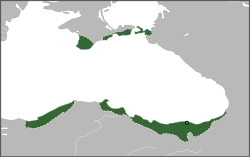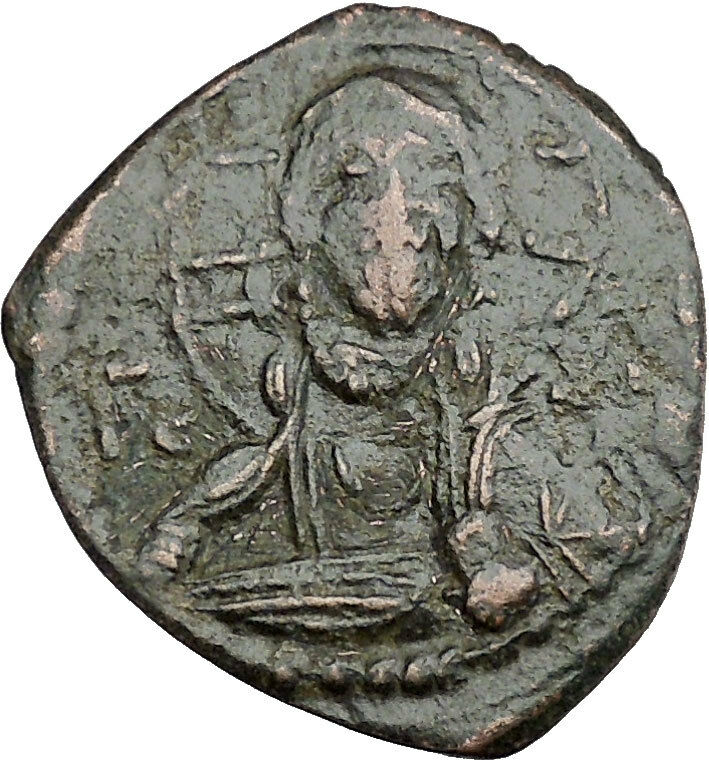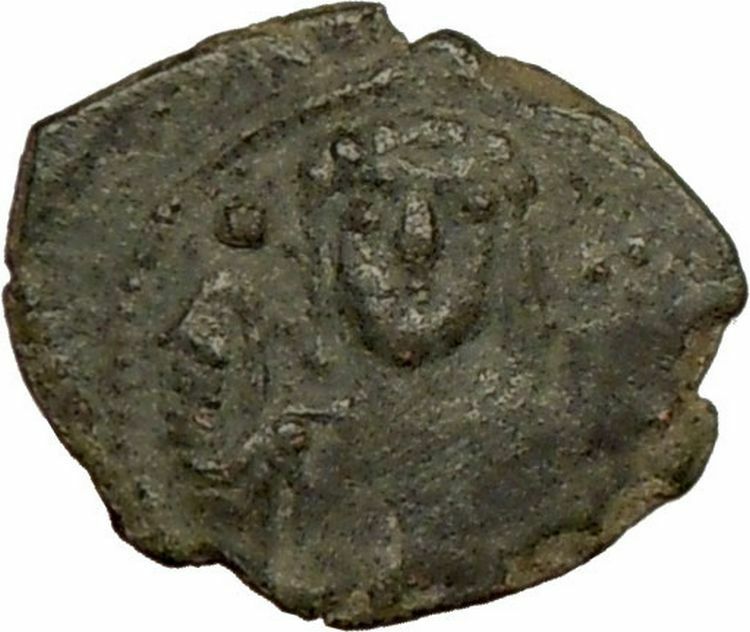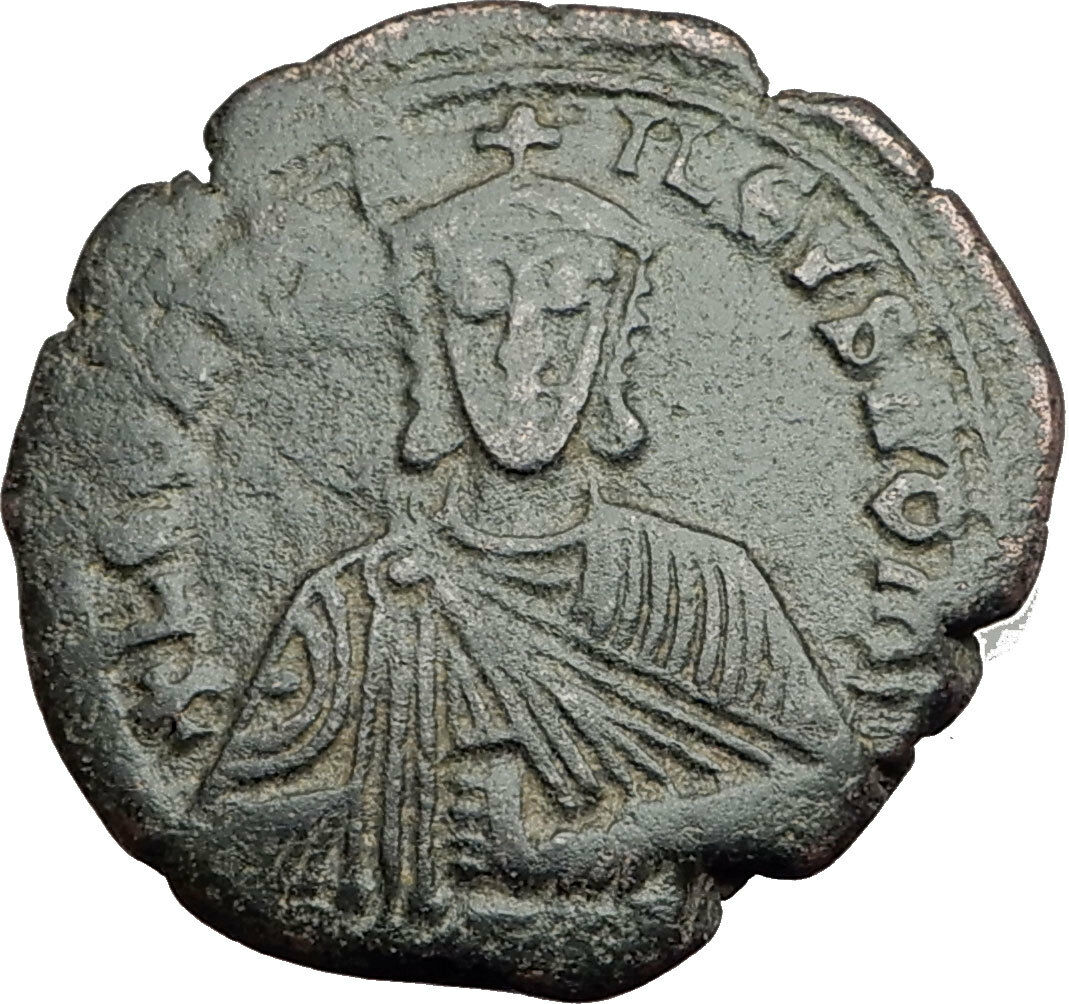|
Byzantine Empire – The Empire of Trebizond
Basil – Emperor: September 1332 – 6 April 1340 A.D.
Silver Asper 20mm (1.80 grams)
Reference: Sear 2622
Certification: NGC Ancients XF 4936285-016
A in circle, ЄV-NΓ, St. Eugenius, nimbate, on horse walking right, cross in right hand.
BA-M, Basil, wearing crown with pendilia, turned facing, on horse walking right, trefoil scepter in right hand.
You are bidding on the exact item pictured, provided with a Certificate of Authenticity and Lifetime Guarantee of Authenticity.
Saint Eugenios or Eugene was martyred under Diocletian and a cult devoted to him developed in Trebizond. His feast day is 21 January. Eugenios along with the martyrs Candidus, Valerian and Aquila was persecuted during the reign of Diocletian (284-305) and Maximian (305-311). The four hid in the mountains above Trebizond, but were eventually found and brought before the regimental commander Lycius. They were flogged, tortured with fire and eventually beheaded. Eugenios is credited with the destruction of the image on the “gray hill” overlooking the city, later known as the Mithratis.
The Komnenian rulers of the Empire of Trebizond adopted the saint as the patron of their country. His alleged miracles include assisting Trebizond to repel a siege of the city by the Seljuk Turks in 1224. His image appears frequently on Trapezuntine coins. The cult and pilgrimage around this saint never really developed beyond Trebizond’s borders, although John Lazaropoulos, Metropolitan of Trebizond in the name Joseph, collected the miracles of St. Eugenios into one book in the 14th century.
A monastery dedicated to him existed in Trebizond: Rosenqvist identifies it consisted of a structure on Mount Minthrion with an associated church, and a metochion inside the city walls. There is evidence that the monastery was in existence at least as early as the ninth century; a typikon composed in 1346 provides details of the monastic community’s life.
According to the Orthodox Church in America, his prayer is thus:
“Your holy martyr Eugene, O Lord, Through his sufferings has received an incorruptible crown from You, our God.
For having Your strength, he laid low his adversaries, And shattered the powerless boldness of demons.
Through his intercessions, save our souls!
Basil Megas Komnenos (Medieval Greek: Βασίλειος Μέγας Κομνηνός, romanized: Basileios Megas Komnēnos) (died 6 April 1340) was Emperor of Trebizond from August 1332 until his death in 1340. Although Basil’s reign was a period of stability during the civil war that dominated the pocket empire during the second quarter of the 14th century, some of that conflict had its origins in his marital actions.
Basil was a younger son of Emperor Alexios II of Trebizond and his wife Djiadjak Jaqeli. When his oldest brother Andronikos III assumed the throne in 1330 and killed his two brothers (Michael and George), Basil happened to be in Constantinople and escaped his brothers’ fate.
On the death of Andronikos III, his infant son Manuel II became emperor. However, Basil was invited from Constantinople to take the throne; Manuel was deposed in August 1332 and confined to a monastery. Basil purged the court of his brother and nephew’s supporters (which included the megas doux Lekes Tzatzintzaios and his son the megas domestikos Tzambas), but the man he appointed as the new megas doux, John the Eunuch, revolted in favor of the deposed Manuel. The revolt was crushed and to prevent further trouble the child was murdered in 1333, probably on Basil’s order.
Despite Basil’s return, the factional strife continued. According to George Finlay, the great officers and principal nobles had become petty sovereigns, reducing the countryside to anarchy. The Scholarioi, the militia of capital, became so insubordinate that Basil had to hire foreign mercenaries to protect his person, but through their arrogance and corruption they rapidly made themselves and their master hated. Such was his unpopularity with the people of the city, that when a solar eclipse took place they took it for a sign of divine wrath and forced the emperor to seek refuge in the citadel and tried to pelt him with stones.
On 17 September 1334, Basil formed a marriage alliance with the Byzantine Emperor Andronikos III Palaiologos by marrying his illegitimate daughter Irene. The affection between the two soon cooled, and Basil took a mistress also named Irene, by whom he fathered four illegitimate children. Whether or not he was actually divorced from his wife remains uncertain, but there is an interesting letter from the Patriarch of Constantinople, John XIV Kalekas, to Gregory the metropolitan of Trebizond. In this letter the Patriarch reprimands the metropolitan, and all the other ordained men at Trebizond, for the wickedness they had allowed to take place to the injury of the holy canons, and orders them to resolve this problem on the pain of alienating the main body of the Church. The local clergy, however, contented themselves with the pretense that they were actually honoring the legitimate empress in their services since they were honoring an Irene.
The uneasy situation at the capital was exploited by the Turkmen Sheikh Hassan, who attacked Trebizond 5 July 1335. The fighting centered at the palisade of Saint Kerykios and on Mount Minthrion, but a providential rainstorm allowed the Trapezuntines to rout the attackers.
Basil died 6 April 1340, apparently poisoned by his legitimate wife Irene Palaiologina, who promptly seized the throne.
 The Empire of Trebizond or Trapezuntine Empire was a monarchy and one of three successor rump states of the Byzantine Empire that flourished during the 13th through 15th centuries, consisting of the far northeastern corner of Anatolia (the Pontus) and the southern Crimea. The empire was formed in 1204 after the Georgian expedition in Chaldia and Paphlagonia, commanded by Alexios Komnenos a few weeks before the sack of Constantinople. Alexios later declared himself Emperor and established himself in Trebizond (modern day Trabzon, Turkey). Alexios and David Komnenos, grandsons and last male descendants of deposed Emperor Andronikos I Komnenos, pressed their claims as “Roman Emperors” against Byzantine Emperor Alexios V Doukas. The later Byzantine emperors, as well as Byzantine authors, such as George Pachymeres, Nicephorus Gregoras and to some extent Trapezuntines such as John Lazaropoulos and Basilios Bessarion, regarded the emperors of Trebizond as the “princes of the Lazes”, while the possession of these “princes” was also called Lazica, in other words, their state was known as the Principality of the Lazes. Thus from the point of view of the Byzantine writers connected with the Laskaris and later with the Palaiologos dynasties, the rulers of Trebizond were not emperors. The Empire of Trebizond or Trapezuntine Empire was a monarchy and one of three successor rump states of the Byzantine Empire that flourished during the 13th through 15th centuries, consisting of the far northeastern corner of Anatolia (the Pontus) and the southern Crimea. The empire was formed in 1204 after the Georgian expedition in Chaldia and Paphlagonia, commanded by Alexios Komnenos a few weeks before the sack of Constantinople. Alexios later declared himself Emperor and established himself in Trebizond (modern day Trabzon, Turkey). Alexios and David Komnenos, grandsons and last male descendants of deposed Emperor Andronikos I Komnenos, pressed their claims as “Roman Emperors” against Byzantine Emperor Alexios V Doukas. The later Byzantine emperors, as well as Byzantine authors, such as George Pachymeres, Nicephorus Gregoras and to some extent Trapezuntines such as John Lazaropoulos and Basilios Bessarion, regarded the emperors of Trebizond as the “princes of the Lazes”, while the possession of these “princes” was also called Lazica, in other words, their state was known as the Principality of the Lazes. Thus from the point of view of the Byzantine writers connected with the Laskaris and later with the Palaiologos dynasties, the rulers of Trebizond were not emperors.
After the crusaders of the Fourth Crusade overthrew Alexios V and established the Latin Empire, the Empire of Trebizond became one of three Byzantine successor states to claim the imperial throne, alongside the Empire of Nicaea under the Laskaris family and the Despotate of Epirus under a branch of the Angelos family. The ensuing wars would see the Empire of Thessalonica, the imperial government that sprung from Epirus, collapse following conflicts with Nicaea and Bulgaria and the final recapture of Constantinople by the Empire of Nicaea in 1261. Despite the Nicaean reconquest of Constantinople, the Emperors of Trebizond would continue to style themselves as “Roman Emperors” for two decades and continued to press their claim on the Imperial throne. Emperor John II of Trebizond officially gave up the Trapezuntine claim to the Roman imperial title and Constantinople itself 21 years after the Nicaeans recaptured the city, altering his imperial title from “Emperor and Autocrat of the Romans” to “Emperor and Autocrat of all the East, Iberia and Perateia”.
The Trapezuntine monarchy would survive the longest among the Byzantine successor states. The Despotate of Epirus had ceased to contest the Byzantine throne even before the Nicaean reconquest and was briefly occupied by the restored Byzantine Empire c. 1340, thereafter becoming a Serbian dependency later inherited by Italians, ultimately falling to the Ottoman Empire in 1479. Whilst the Empire of Nicaea had restored the Byzantine Empire through restoring control of the capital, it ended in 1453 with the conquest of Constantinople by the Ottomans. Trebizond would last until 1461 when the Ottoman Sultan Mehmed II conquered it after a month-long siege and took its ruler and his family into captivity, marking the final end of the Roman imperial tradition initiated by Augustus 1,488 years previously. The Crimean Principality of Theodoro, an offshoot of Trebizond, lasted another 14 years, falling to the Ottomans in 1475.
|









 The Empire of Trebizond or Trapezuntine Empire was a monarchy and one of three successor rump states of the Byzantine Empire that flourished during the 13th through 15th centuries, consisting of the far northeastern corner of Anatolia (the Pontus) and the southern Crimea. The empire was formed in 1204 after the Georgian expedition in Chaldia and Paphlagonia, commanded by Alexios Komnenos a few weeks before the sack of Constantinople. Alexios later declared himself Emperor and established himself in Trebizond (modern day Trabzon, Turkey). Alexios and David Komnenos, grandsons and last male descendants of deposed Emperor Andronikos I Komnenos, pressed their claims as “Roman Emperors” against Byzantine Emperor Alexios V Doukas. The later Byzantine emperors, as well as Byzantine authors, such as George Pachymeres, Nicephorus Gregoras and to some extent Trapezuntines such as John Lazaropoulos and Basilios Bessarion, regarded the emperors of Trebizond as the “princes of the Lazes”, while the possession of these “princes” was also called Lazica, in other words, their state was known as the Principality of the Lazes. Thus from the point of view of the Byzantine writers connected with the Laskaris and later with the Palaiologos dynasties, the rulers of Trebizond were not emperors.
The Empire of Trebizond or Trapezuntine Empire was a monarchy and one of three successor rump states of the Byzantine Empire that flourished during the 13th through 15th centuries, consisting of the far northeastern corner of Anatolia (the Pontus) and the southern Crimea. The empire was formed in 1204 after the Georgian expedition in Chaldia and Paphlagonia, commanded by Alexios Komnenos a few weeks before the sack of Constantinople. Alexios later declared himself Emperor and established himself in Trebizond (modern day Trabzon, Turkey). Alexios and David Komnenos, grandsons and last male descendants of deposed Emperor Andronikos I Komnenos, pressed their claims as “Roman Emperors” against Byzantine Emperor Alexios V Doukas. The later Byzantine emperors, as well as Byzantine authors, such as George Pachymeres, Nicephorus Gregoras and to some extent Trapezuntines such as John Lazaropoulos and Basilios Bessarion, regarded the emperors of Trebizond as the “princes of the Lazes”, while the possession of these “princes” was also called Lazica, in other words, their state was known as the Principality of the Lazes. Thus from the point of view of the Byzantine writers connected with the Laskaris and later with the Palaiologos dynasties, the rulers of Trebizond were not emperors. 




